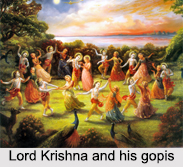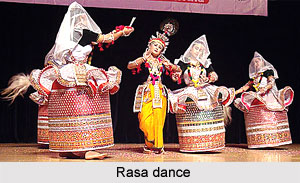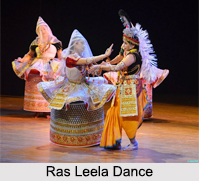Introduction
 Rasa Dance also known as Rasalila is the traditional dance custom of Krishna with the Radha and the Gopis. The traditional stories of Krishna are described in Hindu scriptures like the Bhagavata Purana and literature, the Gita Govinda, where he dances with Radha and her associates or sakhis.
Rasa Dance also known as Rasalila is the traditional dance custom of Krishna with the Radha and the Gopis. The traditional stories of Krishna are described in Hindu scriptures like the Bhagavata Purana and literature, the Gita Govinda, where he dances with Radha and her associates or sakhis.
The term, `rasa` means emotion or performance and `lila` is a concept from Hinduism, which roughly translates to `play or lila of the dance or rasa`. Thus, Rasa Dance is known as the "Dance of Divine Love".
In rasa dance of Manipur lie the richness of both Nritta and abhinaya of the Manipuri style. Here the art attains a certain level of perfection and stylization. These are compositions of a literary order set to classical music and performed to a given metrical cycle. King Bhagyachandra has composed three of the four rasa dances known to Manipur. A quick glimpse into the history of Rasa Dance will lead one to the love poetry of the Vaishnavite sages, such as, Chaitanya, Surdas, Jayadeva and others. These love ballads were set to music and later adapted to dance forms.
Literature of Rasa
The literature is Vaishnavite, simultaneously giving full scope to the actors to present the various nayikas of the Indian aesthetic tradition and the several Sthayi Bhavas mentioned in Natyashastra. Through the various episodes of the rasa a dominant mood called Karuna is created. By presenting a transitory state a configuration is produced of a dominant state of being. Through each sequence the dancers present several vyabhichari Bhavas. The various rhythms of the bhangis give full scope to the dancer to present variations on a given theme. The songs of Jayadeva from the Gita Govinda or Vidyapati`s Padavali or the works of other poets of the Bhakti school are woven into the rasa dances.
Dance of Krishna
 The dance of Krishna and the cowherds forms another group where only an episode of the playful Krishna is presented. The two goshta bhangis along with the goshta nartana or the gopa rasa complete the repertoire of Manipuri dance. Many episodes of playful Krishna are presented; it may be the episode of killing the demon Bakasura or the story of the playful child stealing butter. The vatsalya bhava is dominant and an ecstatic mood is created. These episodes are enacted by the dancer impersonating Krishna. The aim is to present the ambivalence of the human attitude to this child-god. Ultimately the actor who enacts the role either of Krishna, or Yashoda, or gopis represents humanity looking up, yearning for identity with the God. According to the history of Manipuri classical dances the traditional Rasa Lila was of three varieties: the Tal Rasak, the Danda Rasak and the Mandal Rasak. In all these three forms of Rasa Lila the story depicted revolved around Lord Krishna and his divine love, Radha.
The dance of Krishna and the cowherds forms another group where only an episode of the playful Krishna is presented. The two goshta bhangis along with the goshta nartana or the gopa rasa complete the repertoire of Manipuri dance. Many episodes of playful Krishna are presented; it may be the episode of killing the demon Bakasura or the story of the playful child stealing butter. The vatsalya bhava is dominant and an ecstatic mood is created. These episodes are enacted by the dancer impersonating Krishna. The aim is to present the ambivalence of the human attitude to this child-god. Ultimately the actor who enacts the role either of Krishna, or Yashoda, or gopis represents humanity looking up, yearning for identity with the God. According to the history of Manipuri classical dances the traditional Rasa Lila was of three varieties: the Tal Rasak, the Danda Rasak and the Mandal Rasak. In all these three forms of Rasa Lila the story depicted revolved around Lord Krishna and his divine love, Radha.
Costumes of Rasa Dance
The costumes of Rasa Lila of Manipur are vibrant and are quite captivating to look at. As far as the dancers are concerned both male and female dancers are part of this splendid act. The richness of the costumes, the poise, the moving music and the devotion with which Rasa Lila is performed is sure to strike an emotional chord.
Manipuri dance evokes a permeating mood of devotion, deep yearning and Karuna. It symbolizes the pangs of separation from the Godhead and reunion with Divinity. Finally all humans are gopis ever seeking, ever desiring, ever yearning for the God who gives the illusion of being personal to each human being and is yet above all of them. Manipuri has a delicate grace and beauty which is full of the intricate complexities of sinuous curves. It is the embodiment of Bhakti as far as its theme and spirit is concerned. The delicate movements, the crescendo of the music and the grace of the dancers make the performance truly a divine one.
Time of Performance
There is the Vasantarasa for the full-moon day of Holi, and the Kunja rasa which is performed on the Rakhi-Purnima in the month of August. Then there is the Maha rasa which is performed on the full-moon day of the Karthika Purnima in the month of October-November. King Chandrakirti added the Nitya rasa, and gopa rasa. These dances follow a definite pattern which gives full scope for single performance. This dance of Manipur is performed in front of the temples. In temple premises, such as, Shri Shri Govindaji in Imphal Ras Lila is commonly performed during Krishna Janmashtami, Basanta Purnima and Karthika Purnima.
Myths of Rasa Dance
The rasa dance is a totally religious presentation. In order to set up this fact, Krishna, the utmost spiritual, expanded himself in many forms and stood next to each gopi. Placing his hands on the shoulders of the gopis on both sides of him, he began to dance in their middle. The spiritualist expansions of Krishna were not perceived by the gopis because Krishna appeared single-handedly to each of them.
 Each gopis thought that Krishna was dancing with her alone. Over that magnificent dance flew many airplanes carrying the denizens of the wonderful planets, who were very worried to see the superb dance of Krishna with the gopis. The Gandharvas and the Kinnaras began to sing, and, accompanied by their respective wives, all the Gandharvas began to shower flowers on the dancers. As the gopis and Krishna danced mutually, a very peaceful musical sound was produced from the tinkling of their bells, ornaments and bangles. It appeared that Krishna was a greenish navy locket in the midst of a golden necklace decorated with priceless stones. While Krishna and the gopis danced, they displayed amazing bodily features. The movements of their legs, their placing their hands on one another, the movements of their eyebrows, their smiling, their clothes, their earrings, their cheeks, their hair with flowers - as they sang and danced these combined together to come into sight like clouds, boom, snow and lightning. Krishna"s bodily features appeared just like a group of clouds, their songs were like thunder, the beauty of the gopis appeared to be just like lightning in the sky and the drops of perspiration noticeable on their faces appeared like falling snow. In this way, both the gopis and Krishna were fully busy in dancing.
Each gopis thought that Krishna was dancing with her alone. Over that magnificent dance flew many airplanes carrying the denizens of the wonderful planets, who were very worried to see the superb dance of Krishna with the gopis. The Gandharvas and the Kinnaras began to sing, and, accompanied by their respective wives, all the Gandharvas began to shower flowers on the dancers. As the gopis and Krishna danced mutually, a very peaceful musical sound was produced from the tinkling of their bells, ornaments and bangles. It appeared that Krishna was a greenish navy locket in the midst of a golden necklace decorated with priceless stones. While Krishna and the gopis danced, they displayed amazing bodily features. The movements of their legs, their placing their hands on one another, the movements of their eyebrows, their smiling, their clothes, their earrings, their cheeks, their hair with flowers - as they sang and danced these combined together to come into sight like clouds, boom, snow and lightning. Krishna"s bodily features appeared just like a group of clouds, their songs were like thunder, the beauty of the gopis appeared to be just like lightning in the sky and the drops of perspiration noticeable on their faces appeared like falling snow. In this way, both the gopis and Krishna were fully busy in dancing.
Performance of Rasa Dance
Rasa Lila is a well-liked form of folk theatre in the regions of Mathura, Vrindavan in Uttar Pradesh, particularly in the festivals of Krishna Janmashtami and Holi and in the middle of different followers of Gaudiya Vaishnavism in the area. Raas Leela is also observed as one of the State Festivals of Assam which regularly is celebrated during late November or early December. Rasa Lila is depicted within Manipuri classical Indian dance and revolves roughly the same story of the love between Krishna and the cowherd girls and tells the heavenly love story of Krishna, svayam bhagavan and Radha, his godly beloved.
Lord Krishna in the middle of the Raas Leela dance depicts that there is a Parmatma or the lord about whom the whole universe is formed. The gopis dance around the lord and they all are considered as the partner of the lord. The gopis were for eternity women and hardly was a man enchanted by Lord Krishna in this form. This too has a deep religious essence.
The dance demonstrates an everlasting love of Radha and Krishna as been described in the Hindu scriptures and puranas. It also reveals the magnificent love of Lord Krishna and Radha as well as the devotion of Gopis towards the Lord. In real dance performance, the eye catching elegant movements and beautiful gestures can be seen. During performance, these movements are controlled very much, that it acquires a touch of religious force.



















